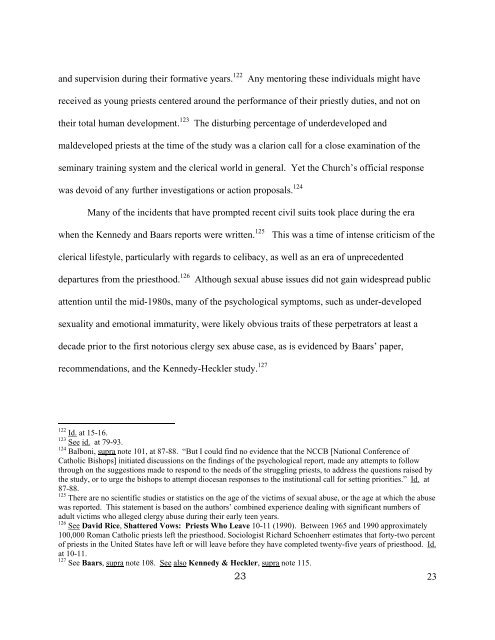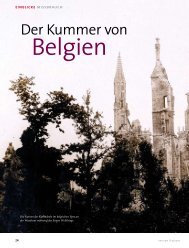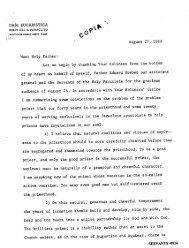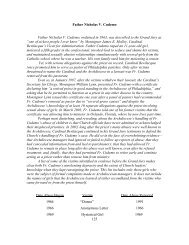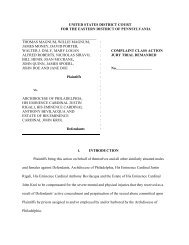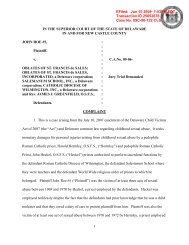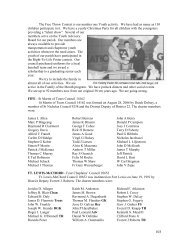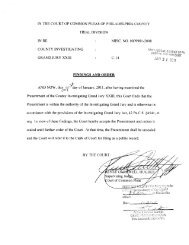1 1 Catholic Clergy Sexual Abuse Meets the Civil Law by Thomas P ...
1 1 Catholic Clergy Sexual Abuse Meets the Civil Law by Thomas P ...
1 1 Catholic Clergy Sexual Abuse Meets the Civil Law by Thomas P ...
You also want an ePaper? Increase the reach of your titles
YUMPU automatically turns print PDFs into web optimized ePapers that Google loves.
and supervision during <strong>the</strong>ir formative years. 122 Any mentoring <strong>the</strong>se individuals might have<br />
received as young priests centered around <strong>the</strong> performance of <strong>the</strong>ir priestly duties, and not on<br />
<strong>the</strong>ir total human development. 123 The disturbing percentage of underdeveloped and<br />
maldeveloped priests at <strong>the</strong> time of <strong>the</strong> study was a clarion call for a close examination of <strong>the</strong><br />
seminary training system and <strong>the</strong> clerical world in general. Yet <strong>the</strong> Church’s official response<br />
was devoid of any fur<strong>the</strong>r investigations or action proposals. 124<br />
Many of <strong>the</strong> incidents that have prompted recent civil suits took place during <strong>the</strong> era<br />
when <strong>the</strong> Kennedy and Baars reports were written. 125 This was a time of intense criticism of <strong>the</strong><br />
clerical lifestyle, particularly with regards to celibacy, as well as an era of unprecedented<br />
departures from <strong>the</strong> priesthood. 126 Although sexual abuse issues did not gain widespread public<br />
attention until <strong>the</strong> mid-1980s, many of <strong>the</strong> psychological symptoms, such as under-developed<br />
sexuality and emotional immaturity, were likely obvious traits of <strong>the</strong>se perpetrators at least a<br />
decade prior to <strong>the</strong> first notorious clergy sex abuse case, as is evidenced <strong>by</strong> Baars’ paper,<br />
recommendations, and <strong>the</strong> Kennedy-Heckler study. 127<br />
122 Id. at 15-16.<br />
123 See id. at 79-93.<br />
124 Balboni, supra note 101, at 87-88. “But I could find no evidence that <strong>the</strong> NCCB [National Conference of<br />
<strong>Catholic</strong> Bishops] initiated discussions on <strong>the</strong> findings of <strong>the</strong> psychological report, made any attempts to follow<br />
through on <strong>the</strong> suggestions made to respond to <strong>the</strong> needs of <strong>the</strong> struggling priests, to address <strong>the</strong> questions raised <strong>by</strong><br />
<strong>the</strong> study, or to urge <strong>the</strong> bishops to attempt diocesan responses to <strong>the</strong> institutional call for setting priorities.” Id. at<br />
87-88.<br />
125 There are no scientific studies or statistics on <strong>the</strong> age of <strong>the</strong> victims of sexual abuse, or <strong>the</strong> age at which <strong>the</strong> abuse<br />
was reported. This statement is based on <strong>the</strong> authors’ combined experience dealing with significant numbers of<br />
adult victims who alleged clergy abuse during <strong>the</strong>ir early teen years.<br />
126 See David Rice, Shattered Vows: Priests Who Leave 10-11 (1990). Between 1965 and 1990 approximately<br />
100,000 Roman <strong>Catholic</strong> priests left <strong>the</strong> priesthood. Sociologist Richard Schoenherr estimates that forty-two percent<br />
of priests in <strong>the</strong> United States have left or will leave before <strong>the</strong>y have completed twenty-five years of priesthood. Id.<br />
at 10-11.<br />
127 See Baars, supra note 108. See also Kennedy & Heckler, supra note 115.<br />
23<br />
23


